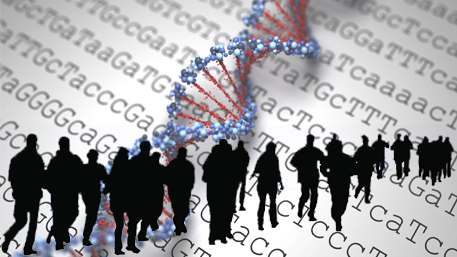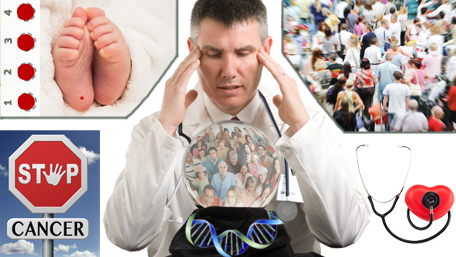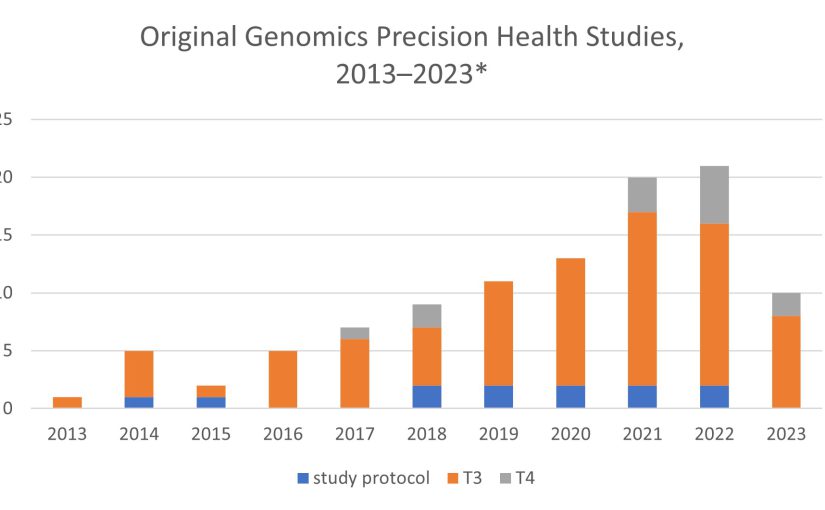Search Results
10 results for newborn screening
From Genes to Public Health: Building the Evidence Base for DNA-based Population Screening

This blog post is a summary of our recent commentary in Genetics in Medicine. The use of genetics in population screening long predates the Human Genome Project. For more than 60 years, newborn screening has been a successful public health program that has resulted in major improvements in outcomes for infants with genetic and other
Posted on byLet’s not get too excited about genome sequencing of healthy newborns. Here’s why!

Newborn screening (NBS) is the largest public health genetics program around the world. Each year in the United States, thousands of babies are saved from lifelong disability and death by timely diagnosis and treatment. While most newborns are screened with biochemical tests that use drops of blood from a heel prick, new advances in genome
Posted on by 1 CommentImplementing Genomics-Based Screening Programs for Healthy Adults: A Proposed Evidence-based Approach from the Genomics and Population Health Action Collaborative

The following report was developed by the Genomics and Population Health Action Collaborative (GPHAC) as a potential roadmap for groups planning to carry out projects involving genomics-based screening programs in the healthy adult populations. The report is available in its entirety on the National Academy of Science, Engineering and Medicine website. The advent of next
Posted on byCan we use genetic screening of healthy populations to save lives and prevent disease? Join the conversation.

On January 30, 2017, CDC held a special workshop to discuss the role of public health in the implementation of genetic screening programs beyond the newborn period. The workshop brought together panelists from the worlds of medical genetics and public health practice, including cancer, birth defects, and laboratory science. Workshop presenters and a CDC panel discussed
Posted on by 6 CommentsThe Cancer Moonshot, Hereditary Cancers and Population Genetic Screening

In September 2016, the Cancer Moonshot Blue Ribbon Panel delivered a report with 10 ambitious recommendations to shape cancer research for the next five years. One recommendation is to “expand use of proven prevention and early detection strategies.” [PDF 199 KB] There is a lot we can do to prevent cancer now— even with no
Posted on byHow Can We Use Genetic Testing in Population Screening for Common Diseases?

Scientific and implementation challenges Population screening for disease is a concept that has been around for many decades. Its main purpose is early detection and treatment of asymptomatic disease, or risk assessment and prevention of future disease, in order to improve health outcomes in individuals and populations. Examples include mammography in breast cancer screening and
Posted on by 1 CommentFrom Genetic Counseling in Individuals to Cascade Screening in Populations: An Emerging Role for Public Health Practice

There are more than 2500 diseases for which genetic testing is currently available. Most of these diseases are individually rare conditions but collectively affect millions of individuals and families worldwide. Genetic diseases are usually caused by mutations in one or a few genes that may confer a high risk of illness, disability and early death.
Posted on by 1 CommentTracking the Contributions of Implementation Science to the Population Health Impact of Genomics and Precision Health: A New Knowledge Base

Successful implementation of evidence-based genomic and precision health interventions requires an understanding of what works and what doesn’t work within the context of various clinical and public health settings. Research and evaluation that incorporate implementation science tools and methods into the translation of these interventions facilitate this. Here we present a new CDC knowledge base,
Posted on by 1 CommentPreventing Disease and Protecting Health Among Individuals at Increased Genetic Risk: A Lifespan Perspective and an Emerging Public Health Challenge

Since the completion of the Human Genome Project, major advances have occurred in the translation of human genome discoveries into clinical practice and disease prevention. As almost all human diseases are due to complex gene-environment interactions, the applications of human genomics should be pertinent to the prevention and control of many diseases, including rare and
Posted on byPublic Health Genomics at the Centers for Disease Control and Prevention: Happy 25th Anniversary!

In 1997, in response to the Human Genome Project, the CDC formed the Office of Genetics and Disease Prevention, now called the Office of Genomics and Precision Public Health (OGPPH). This was the beginning of the public health genomics movement in the United States and around the world. Our office continues to serve CDC programs,
Posted on by 1 Comment